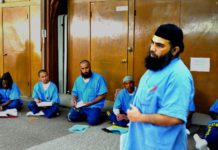by Wanda Sabir
Editor’s note: My sincere apologies for the late posting of Wanda’s Picks for May. I hope never to be late again, but any time you don’t see it here, please visit www.wandaspicks.com, where the original is posted as soon as it’s written.
Happy Mother’s Day! We remember Lorraine Hansberry Theater co-founder, Quentin Easter, who passed Wednesday, April 28. He was 53. And offer condolences to his partner, Stanley E. Williams. Visit www.lhtsf.org.
 We also lost the great Lena Horne this month on Mother’s Day, May 9. She was 92, her birthday June 17, 1917 – her funeral Friday, May 14, in Manhattan at St. Ignatius Loyola on Park Avenue. I think it’s cool that her church has the same name as the chapel at the University of San Francisco where my commencement was held when I got my master’s degree. I wonder if it is a Jesuit church as well. I found out recently that Ms. Horne was at the March on Washington with sisters Mahalia Jackson and Dorothy Height.
We also lost the great Lena Horne this month on Mother’s Day, May 9. She was 92, her birthday June 17, 1917 – her funeral Friday, May 14, in Manhattan at St. Ignatius Loyola on Park Avenue. I think it’s cool that her church has the same name as the chapel at the University of San Francisco where my commencement was held when I got my master’s degree. I wonder if it is a Jesuit church as well. I found out recently that Ms. Horne was at the March on Washington with sisters Mahalia Jackson and Dorothy Height.
Congratulations to all graduates from colleges and universities, elementary schools to middle and high school!
Moonchild
by Lucille Clifton
whatever slid into my mother’s room that
late june night, tapping her great belly,
summoned me out roundheaded and unsmiling.
is this the moon, my father used to grin,
cradling me?
it was the moon
but nobody knew it then.
the moon understands dark places.
the moon has secrets of her own.
she holds what light she can.
we girls were ten years old and giggling
in our hand-me-downs, we wanted breasts,
pretended that we had them, tissued
our undershirts. Jay Johnson is teaching
me to french kiss, ella bragged, who
 is teaching you? how do you say; my father?
is teaching you? how do you say; my father?
the moon is queen of everything.
she rules the oceans, rivers, rain.
when I asked whose tears these are
I always blame the moon
– from “Blessing the Boats: New and Selected Poems 1988-2000”
We lost this wonderful poet this year.
Happy Mother’s Day! Ashay!
On the fly
The Oakland Museum is open again. Visit www.museumca.org. Regina Carter is bringing her latest project to SFJAZZ at the Herbst Theatre May 28. Listen to Wanda’s Picks Radio show on May 26, 6-7:30 a.m., www.blogtalkradio.com/wandas-picks. Visit www.reginacarter.com and www.sfjazz.com. Professor Wanda Sabir co-hosts “Haiti Awareness Day” at the College of Alameda, Tuesday, May 18, 12:30 to 2 p.m., in the Student Lounge, F-Building. It is free. Also at the College of Alameda, Professor Herbert Mims’ Small Combo class performs along with bands from local high schools. The concert is Thursday, May 20, in the F-Building, 6-8 p.m.
KBLA is hosting its Stone Soul Picnic Memorial Day Weekend, I think May 30. Also the Black and White Ball, San Francisco’s annual fundraiser for the SF Symphony, is May 22. Cool and the Gang are among the headliners. The Malcolm X Jazz Arts Festival is also May 22, 11 to 7, at San Antonio Park. It’s a free event. Visit www.eastsideartsalliance.org or call (510) 533-6629. The Eighth Annual Small Business Symposium is Friday, May 28, 8 a.m. to 5 p.m. in the Oakland Marriott City Center. It’s free. Register online at www.oaklandsmallbusiness.com or for application smallbusiness@oaklandnet.com or (510) 986-2855 (24-hour message center).
Digital Story Station wants East Oakland stories about growing up in East Oakland, raising a family here, being new to Oakland. Interested? Call (510) 238-7075 and visit www.oaklandlibrary.org. Staff at the Eastmont Library will create a 3-5 minute video that may become a part of the California of the Past online collection at www.digitalstorystation.com. The finished recording can include music and photos, letters and the individual’s voice and image. It’s free.
City College of San Francisco is hosting “Open College” this summer to protest the budget cuts to higher education and cancellation of summer school there. Open College days are Wednesdays, June 2, July 14 and Aug. 14, at the Ocean Campus, tentatively from 10 a.m. to 6 p.m. Visit www.ccsfagainstbudgetcuts.org. San Francisco International Arts Festival kicks off Wednesday, May 19. Visit www.sfiaf.org for the schedule or see page 2 of the May Bay View in print.
African America Making Connections 2010
The event sponsored by Supervisor Keith Carson Saturday morning, May 1, was a refreshing change to gatherings inspired by tragedy or loss. While Oscar Grant’s murder and the Lovelle Mixon shootout, the Haiti earthquake, famine, warfare and rape in Congo, Darfur and the anniversary of the Rwanda massacre recently passed are all rallying points, Saturday morning, May 1, the day when folks worldwide look at the plight of workers and organizing efforts to support just and fair wages and work conditions, plus in the San Francisco Bay Area, immigrant rights, Black people were invited to gather to share best practices and good news.
The buzz started as people found the Newton-Seale Conference Room, got their name tags, packages, programs and four dots to put on a sheet identifying their areas of concern. At the end of the conference, charts with headings – youth, health, economic development, education, art and culture, public safety – were decorated with these red, black and green dots. Leading concerns were youth, health, education and economic development. It’s interesting that public safety was not one of the top counts. Health had more dots than economic development and education had the most of any category.
Rep. Barbara Lee gave a state of the Black community account, followed by a similar account regarding California by Assemblyman Sandre Swanson. Minister Keith Muhammad seconded many others who agreed that organization was key to African people getting their work done. In the breakout session, more than one organizational leader offered assistance to fellow organizations seated who needed help with fund development and other such expertise.
Dr. Robert Adams welcomed the hundreds gathered to Merritt College, as did Chancellor Elihu Harris, who, despite the negative media, was praised by Rep. Lee as the best chancellor Peralta has had in its recent history. Committees reported back after lunch to the full gathering; awardees received their prizes after the youth panel presented. What was great about Africa American Organizations Making Connections was the inclusion of youth at each stage of the event process, from co-directing breakout sessions and panels to active attendance and dialogue with adults about strategies that work.
Dr. Wade Nobles, founder and executive director of the Institute for the Advanced Study of Black Family Life and Culture, Inc., gave the closing plenary: “Culture, the Glue that Binds.” He reviewed principles that guide African life and the values that make us human, reaching back to ancient Kemet, moving into the present. There are some things which haven’t changed for Black people, yet we are not holding ourselves or the organizations we serve or have created to these standards which are spelled out in MAAT: truth, balance, order, reciprocity, morality, law and justice.
Overall the event was a huge success and I look forward to AAOMC II next year when our crops will have multiplied in the ensuing months and we are able to report to the assembly even more growth and success because of this opportunity afforded us to connect as African people concerned about each other and our personal and collective well-being. For information on reports and links to organizations that participated, call (510) 272-6695 or visit www.acgov.org/board/district5.
Melba Moore’s ‘Still Standing’ at the Black Rep
There are stories and then there are stories so shocking one couldn’t make up a story as bad – or good, for that matter. Melba Moore’s “Still Standing,” which had its Bay Area debut at the Black Repertory Group Theatre, was such a tale. The woman who gave us such hits as “This Is It,” “Love’s Comin’ at Ya,” “Livin’ for Your Love,” “Read My Lips” and recently released a new album with Phil Perry, “The Gift of Love,” tells a story which begins in New Jersey with her grandmother, “Mama,” her singing mother, “Mother Dear,” on the road a lot.
It is a story filled with sadness and a lot of happy moments as her life takes turns for the better and worse. Her mother, who is on the road, meets her stepfather, whose name she uses as a stage name. Clement Mooreman has children already and her only child status grows from one to eventually four or five siblings. She even acquires cousins and aunts and uncles and another grandmother. As Moore reflects on this time in her life, she says that everyone played the piano, which meant eventually she did as well. Her parents entertained a lot, so people like Sarah Vaughn, also from New Jersey, would drop by the house. Sounded like her house was filled with music with her parent’s combo rehearsing in the living room and their many guests. The term blessed is not a misnomer when applied to Moore’s life.
Certainly the fact that she stepped from a teaching career after college into acting jobs on Broadway, “Hair” and “Purlie,” the second which garnered a Tony Award, her own talk-variety show with her first serious love, Clifton Davis, singer-song writer well known for Jackson 5 hits “Never Can Say Goodbye” and “Lookin’ Through the Windows.” Now that is both a happy and sad story. There is an intermission where the audience is treated to a series of episodes from their show and then Moore returns for the second half – the tragedy. Yes, it’s like Shakespeare.
 There is a happily ever after, but it only lasts 16 years (smile), purgatory 20, the Moore on stage a vision of loveliness straight out of the ashes. Girlfriend might look like she’s out for the count, but her head never touches the canvas even when Davis leaves her as she struggles to regain her health after bad contraceptive advice, the dissolution of yet another relationship and the maligning of her character and loss of work, estrangement from her daughter in the midst of a spiritual transformation where homeless and penniless Moore finds work and God on location at the same time. Moore miraculously survives and prospers.
There is a happily ever after, but it only lasts 16 years (smile), purgatory 20, the Moore on stage a vision of loveliness straight out of the ashes. Girlfriend might look like she’s out for the count, but her head never touches the canvas even when Davis leaves her as she struggles to regain her health after bad contraceptive advice, the dissolution of yet another relationship and the maligning of her character and loss of work, estrangement from her daughter in the midst of a spiritual transformation where homeless and penniless Moore finds work and God on location at the same time. Moore miraculously survives and prospers.
Moore performs songs from her mother’s songbook, and those of others in the eras as the story twists and turns until it arrives at its finale. She will be back in November 2010 with the one-woman tale workshopped into a full production with the help of Dr. Mona Vaughn Scott, whom Moore met at the National Black Theatre Festival last year.
I had a few unanswered questions at the end of the play: How old was her daughter when she left home? Where is her ex, Charles Huggins, now and why was he not charged in his defamation of character campaign? Why did she come before the judge and get sentenced for going to the press to clear her name and for documentation of the harassment she and her daughter were experiencing?
“Still Standing” as a play will have its debut here – questions and loose ends tied up. I certainly recommend the show even without dramaturgy. Moore is a great storyteller.
As tears came to my eyes watching the play, I wondered how she could tell it straight, often two shows in one day, without tears. Small in size, the woman is a powerful testament to the power of love and faith: They were the two forces or pillars in the storm which kept her from drowning and still standing when the waves subsided and the flood waters receded. Visit www.melbamoore.com and www.blackrepertorygroup.com. The Black Repertory Group Theatre is located at 3201 Adeline St., Berkeley, (510) 652-2120.
‘A Place Out of Time: The Bordentown School’ on PBS
I had never heard of South New Jersey, but an educational institution was founded there, the Bordentown School, started by a formerly enslaved man, which went on to graduate the future leaders of this country, the future civil rights leaders. “In its prime, the Bordentown School was nicknamed the ‘Tuskegee of the North,’ after Booker T. Washington’s famous Alabama institute. With its 400-acre Georgian style campus, Bordentown could be mistaken for an elite private boarding school. But it was actually a co-educational public school operated by the state of New Jersey, which closed the school in 1955 after the landmark Brown v. Board of Education decision,” according to pbs.org. Its story is told in the film, “A Place Out of Time: The Bordentown School,” which premieres on PBS May 24.
It is amazing how when Brown vs. Board of Education passed and the public institution was made to integrate, the school was threatened with closure because only two white families wanted to send their children there. But this was just the latest in a series of threatened closures by the Jim Crow North, which wanted to keep academics out of the curriculum and make sure that its predominately Black or solely Black school only prepared its students, who boarded there, for domestic jobs.
“A Place Out of Time: The Bordentown School,” directed by David Davidson, narrated by Ruby Dee, and produced by Davidson and Amber Edwards, shows how this best kept secret quietly just kept graduating Black children who went on to serve as advisors to generals and presidents. It quietly made America into a democracy benefiting all citizens.
Told through archival footage and more recent interviews with surviving alumni, the film shows the students on family visit day parading on the vast lawns. One also sees students working in the various trades and later in the laboratories in one of the many college prep classes.
 Students took pride in their institution and in each other. I found it remarkable hearing one of the many alumni interviewed (class of ‘48-’55) speaking of how the boys were on one side of the institution and the girls on another and how the two sides stayed separate. How the kids didn’t want to mess up and get sent home, how they might cry when sent away there and then cry when they had to leave.
Students took pride in their institution and in each other. I found it remarkable hearing one of the many alumni interviewed (class of ‘48-’55) speaking of how the boys were on one side of the institution and the girls on another and how the two sides stayed separate. How the kids didn’t want to mess up and get sent home, how they might cry when sent away there and then cry when they had to leave.
One scholar says how she made more money in cosmetology than she did as a professor now. All kids graduated with a trade. The balance the administrators were able to maintain, along with their dignity, despite the insulting paternalism that pervaded – and pervades – this country when it comes to Black liberation in both the North and the South was amazing to watch.
Yet, despite the good the institution was doing for a population which was not being served – African Americans migrating North from a more overtly segregated South, homeless children and families with single parent heads of household and the poor in the Black community – its closure was highly debated on several occasions by legislators.
Bordentown School instilled pride and discipline into its children. Over and over in the film, alumni spoke of how much faculty, staff and the director loved them and how much pride they all took in the school, which, if you can believe this, was shut down and converted into a mental hospital. At the time of the reunion, which is where the story starts, it is now a juvenile prison. (This school speaks to MAAT and the values Dr. Wade Nobles spoke of in his talk at African American Organizations Making Connections this past weekend.)
At the close of the hour long film, one of the alumni tells the children seated in orange jumpsuits, “Unlike you, we came here by choice.” This telling statement shows how after several short generations how necessary such institutions like Bordentown still are for the very same reasons it was needed then. The demise of Bordentown School is a classic example of the damages of integration. It reminded me of the Makulla Godwin film, “A Jewel in History: The Story of Homer G. Phillips Hospital for Colored,” about the Black run and operated hospital which was closed after it lost its funding after integration and its closure’s impact on the Black community. Its closure and that of Bordentown was a tremor felt throughout the country.
The state of Black health and by extension Black education is not accidental. When Black people were in charge of the education and healthcare of our people, we were better informed and healthier than now. How can one expect a system which doesn’t respect one’s legacy and value prepare one for leadership? Public education and public health have become the new or latest form of Black annihilation. Visit http://www.nurseweek.com/news/features/01-02/homer.asp.
There are parts of the story which remind me a meeting held more than a century ago where Africa was divided into sections by certain European heads of state claiming areas of the continent as property. The meeting was called the Berlin Conference in 1883-1884 and, of course, Africa was not at the table. A similar conference happened here in the United States to determine the state of African American education. The problem: No Black educators were invited, but they heard about it and the policies developed and codified impacted schools like Bordentown School.
I loved it when Booker T. Washington was consulted about Bordentown School and his intersession appeased the white Northerners who didn’t want Black people too educated. Washington knew how to work it so the New Jersey Board of Education was happy and so that the school could operate without interference. Confrontation would have shut the school down.
Eventually the difference between Bordentown School and Tuskegee, that Tuskegee was a private institution and Bordentown went from being private to public when it expanded, was the reason why it was shut down. The state of New Jersey could shut it down, and the governor at that time did. What did Malcolm say about an educated Black man? And he wasn’t even born when Bordentown School prospered.
The excellent film premieres on PBS, Monday, May 24. Check local listings for the time: http://www.pbs.org/aplaceoutoftime/.
San Francisco International Film Festival
The 53rd Annual San Francisco International Film Festival concluded May 6. “Rejoice and Shout,” directed by Don McGlynn (115 min.), a film about the history of gospel music, was awesome – story and cinematography. Thematically there seems to be an emphasis on films this year which look at displaced descendants of colonists. The first such film I saw, “White Material,” takes place in a fictional former French colony where, on the brink of civil war, a white woman refuses to leave the country to the detriment of her entire family.
As I sat in the Pacific Film Archive Theatre, anxiety building because the film is dramatic, I almost fell off my seat many times. I just couldn’t understand why the woman wouldn’t leave the country – why she chose to stay and fight, why she thought she could win. Does white supremacy blind one to reality, all except the fiction posing as reality in one’s head?
The following week when I went to San Francisco to see “Mugabe and the White African,” I was like wow. These characters exist. The white settlers, post-Cecil Rhodes, who had the audacity to name a country after himself, centuries later refuse to leave the Great Zimbabwe when squatters’ rights are up.
It doesn’t matter if they bought the land. Whoever sold it to them didn’t have that right. Besides that, if a country’s leaders say: Hey, visitor, we want you to leave, why wouldn’t you go? The subjects take President Mugabe to court. It takes seven years for the case to get a date for a hearing in the International Tribunal court meeting in Namibia. The court date is delayed when we enter the story and other farmers are run off their farms, often beaten. The subjects are also beaten and again, before it comes to this, my question is, why not leave? This isn’t your land, no matter if your lineage goes back 100 years.
As one family packed, the African servants crying as well, I wondered why if the white mistress cared so much about her Mary and her husband Joseph, why didn’t she take them with her? Just as in “White Material,” her escaping servants told her that any evacuation was for her and her family, not them. Any Africans found on the wrong side of the fence could be killed, definitely beaten, yet these “white Africans” left these Black servants, whom they loved, to their uncertain, certainly more likely than unlikely unfavorable fate.
What impressed me – within the obvious propaganda, was the directors’ commitment to the project and the lengths they went to to smuggle the camera in and the film out of Zimbabwe sometimes through six, seven or eight countries. The co-director spoke of assembling and breaking the camera down many times in one shoot. When asked about why the directors intentionally left out a brief history lesson on the colonial hands reach into Black Zimbabwe which would explain why the indigenous people are so angry, the co-director said money was the reason why they made this pseudo-documentary, a lie masquerading as truth.
One patron, the afternoon I saw the film, said it would have been easy to trace the ownership of these disputed parcels by ethnic groups who predate the Berlin Conference. The claim to land, clearly appropriated illegally from Africans by the British, is clear. The film “Banished” looks at a similar plight in American towns where Black people were told to pack their belongings and get moving before dusk caught them.
‘Night Catches Us’
“Night Catches Us,” directed by Tanya Hamilton, screens Monday, May 3, and Thursday, May 6, 9 p.m., at the Kabuki. The director said the title is taken from a saying from her Jamaican roots sort of like what parents say before we run outside: “Be in the house before dark. Don’t let night catch you outside!” But ultimately night sometimes catches us and when we are caught in those places both emotional and psychological where clarity is obscured, what should we do? Night seems to catch Black people a lot, whether they live in Dakar, Senegal, Port-au-Prince, Haiti, or Germantown, Philadelphia. The street lamps don’t seem to work as well in Black communities, just like our words, which seem to get stuck in our throats, behind our tongues and between our lips when so much is riding on an articulate truth.
The story, set in Philadelphia, looks at the veterans of the Black Power Movement once they return home. What’s happening in the communities they left behind while they were gone? What work remains unresolved? What secrets did their disappearance hide? What mechanisms still remain unresolved, like COINTELPRO? Is the government still in the spy business, are people still being set up? How do the youth reconcile the lore with the reality? Who do they believe? Who is left to save them or help them save themselves?
Hamilton’s characters are vivid and compelling and her all-star cast, with Kerry Washington, Anthony Mackie and Jamie Hector, is impressive as well. The score composed by Philly’s Roots bridges the past with the present: the legacy of the Black Power Movements linked to the present in a way that answers some of my former queries with “the struggle continues.” Aluta continua!
All power belongs to the people who seize the times and take charge of their destiny, like Jimmy, the young adult – 18-year-old – revolutionary who knows something is wrong but doesn’t want any guidance. Ultimately “Night Catches Us” is about the disconnect between generations and how this absence of communication is what is killing us.
Jimmy’s death might have been prevented if he’d listened, but Jimmy was also traumatized. He might not have fought in the war, but he was certainly affected: lost father and other relatives to the battle and lost his sanity in the process. “Night Catches Us” speaks to the fact that we in the Black community need healing, personal and collective, and that the forces which decimated the Black Power Movements still exist and are still operative – the enemy now for the most part internal, but external as well in sanctioned structural bias, like racism, within public institutions like police departments and public schools.
Inspired by Harper Lee’s “To Kill A Mockingbird,” its 40th anniversary year of publication this year as well, the director said over the 10 years she was working on getting the film produced she looked at having a little girl tell the story, the way “Scout” tells the story in Lee’s tale. I wonder when the film concludes what the child would think if she knew how her father was really killed and, knowing what she knows, how does this affect her ability to trust Black men. Visit www.sfiff.org.
‘Alamar’
“Alamar,” directed by Pedro Gonzalez-Rubio (Mexico 2009, 73 min), I have to say, was my favorite film this season, besides “Rejoice and Shout” (smile). It was a wonderful meditation on the temporal nature of life and the beauty that happens when human beings respect their natural environment. The story takes place in a natural reserve, one of the world’s second largest coral reefs in Southern Mexico, Banco Chinchorro. I can’t help but think about the barges traveling in the Gulf of Mexico and the potential for spills and why more isn’t done to stop offshore drilling.
“Alamar” lets us know what is at stake when we don’t pay attention, Gonzalez-Rubio’s film the result of paying attention to what’s important: our relationships. The relationship between the father and his 5-year-old son, who is visiting for the summer which has to eventually end, his life with his mother in Italy, is so beautiful. The father lives on a riverboat house with his father and mentor, a fisherman whose life revolves around taking his boat out daily to catch fish and diving beneath the water for the crustaceans that live in underground caves. The father teaches his son to respect the birds who visit, the crocodiles who live just below the boathouse and hover not far from the shore. They rough-house and then sleep in hammocks, which sway to the rocking of the house on the water. The son and father have the same build and some of the shots are just exquisite.
It’s like wow – where was the camera when they play or when the dad is singing and his son wraps himself up completely in the woven hammock like he is a mollusk escaping into his shell?
The director said after the screening that there was just one camera, his, and that he did all the shooting on this, his first feature. There are times when all we hear is the water or the birds. The underwater shots were taken by other photographers, none of the actors professional – even the story an idea rather than a fully fleshed out production on storyboard. The director was open to magic and let himself be guided once he threw his desire in water and it floated back with an invitation to shoot the film on the boat where all the action takes place.
Besides the extra underwater camera men, the crew was just the director and the sound person. He said when there are too many techs in the crew, one loses the intimacy and organic flow, which is what he was looking for. “Alamar,” which won the New Director’s prize this year at the SFIFF, is opening in New York and hopefully here in the San Francisco Bay Area.
You can become a fan of “Alamar” on Facebook.com.
‘The Day God Walked Away’
Every April a new film about Rwanda pops up and this year is no different, even if the story is. In the pot the condensation tea leaves read: Black people killing other Black people and gloating about it. The difference with “The Day God Walked Away” (France/Belgium 2009, 100 min.) is the perspective. Director Philippe van Leeuw follows a mother, who, abandoned by the white family she worked for, hides out in the ceiling crawl space, then goes to look for her children who were alone when the terror in her immediate neighborhood started. If she’d been with them, they might have survived – typical latchkey tragedy guilt trip. But no one cares except the absent parent, who castigates herself when she finds them murdered and then her neighbors chase her out of her house and won’t let her bury them.
 The character’s descent into madness isn’t immediate, but clearly she has no will to live anymore; it is just a matter of time before she gives into the impulse. When she finds an injured man and nurses him back to health, one sees her perk up, but when he begins to use the tool of death – the machete – in her presence and he has sex with her, she thinks about her babies and tries to prevent one from growing inside her, and the voices in her head grow louder. These are the voices of people she’d heard pleading for their lives, the voices of the Hutu soldiers and roving bands who participated in the killing as well. I am reminded of another film a year ago which looked at two boys, one Hutu, the other Tutsi, who were friends post-100 day massacre, until one boy took the other home.
The character’s descent into madness isn’t immediate, but clearly she has no will to live anymore; it is just a matter of time before she gives into the impulse. When she finds an injured man and nurses him back to health, one sees her perk up, but when he begins to use the tool of death – the machete – in her presence and he has sex with her, she thinks about her babies and tries to prevent one from growing inside her, and the voices in her head grow louder. These are the voices of people she’d heard pleading for their lives, the voices of the Hutu soldiers and roving bands who participated in the killing as well. I am reminded of another film a year ago which looked at two boys, one Hutu, the other Tutsi, who were friends post-100 day massacre, until one boy took the other home.
The woman snaps, picks up the machete and raises it over the head of her sleeping companion. One can imagine the fear he felt when he looked up at the blade. He runs away and she stumbles into the town. Like I said, I am sick of Rwanda tales. It makes the case for “White Material” and “Mugabe and The White African.”
Subtly what these Rwanda and Congo and Sudanese stories about massacres are saying is, Black people don’t know how to rule themselves. It is the new Tarzan series: Africa still untamed and full of savages. It also furthers the paternalism at the heart of the “good master” fictions which further the myth that slavery and European invasions on the African continent did more good than harm.
What is alarming is the damage stories like “Mugabe” and “God Walked Away” do to young minds who lack the historic context which is absent from all the films mentioned here. The children see the callousness of Africans toward white settlers and towards each other and come to the conclusion that Black people are wrong, just wrong – their sympathies with the white South Africans in “Mugabe” and with the woman in “White Material.” The International Court rules in favor of the white family, who eventually lose the farm, but the idea that they can win the case when clearly there is more at stake than the 100-year occupation reminds me of the treaties this government made and broke with the American Indian Nations. At least in America, there is sympathy for the Indian nations, but in Africa, formerly colonized Africa, the only sympathy lies with the wronged white people. It’s Haiti in 1802 all over again. Pay the invaders for their losses. Why? Didn’t they make a profit?
I’m sorry I missed “Northless,” directed by Rigoberto Perecano, and “Soul Kitchen,” directed by Faith Akin. I hope they screen somewhere. However, I am not looking anymore to the SFIFF to be the place for cutting edge films about and by Pan African directors. Only one film was by a Black woman, and that was “Night Catches Us,” which while an important story is a story of tragedy and once again points to the dysfunction that keeps our communities and families fractured and decimated. At one point the child protagonist tells her mother’s friend that her mother keeps secrets and lies. He tells her he doesn’t lie and then lies to her right when the child’s mother was about to free herself with the truth or maybe she wasn’t, but we’ll never know.
It is good there are festivals like the Oakland International Film Festival and the San Francisco Black Film Festival, which I hope has a season this year. I also loved the Pan African Film Festival and look forward to the San Diego Black Film Festival. New York has a Black film festival in the summer in June. More on this later. SFIFF 53 was a wakeup call to Black folks that we really do have to tell our own stories if we want them to be told. We also need to take these films into the public schools so the children will have a counter narrative to perhaps foster a more balanced view of the African Diaspora.
Rockin’ Robin’s Family Play Days at West Oakland Branch Library
A series of parenting workshops for parents and their children ages 0-5 are being offered at the West Oakland Branch Library. Parents and their children can attend all three workshops: May 22, May 29 and June 5, 3-5 p.m., at 1801 Adeline St. There will be story times, fun, hands-on parenting workshops, gift give-a-ways, snacks, crafts and games. Workshops cover topics that include “Taking care of yourself with Blue Skies for Children,” “Learning helpful tips and tricks to improve your life while living with babies and preschoolers,” “Leaping Lizards! The Joy of Music and Movement” with Suellen Primost, “Discover ways to engage young children, encourage their creative expression, and build their self-confidence through rhythm, songs and nursery rhymes,” “Getting your kids to Do What You Want Them to Do with Blue Skies for Children: Explore positive discipline techniques that work, including appropriate consequences, firm boundaries, communication skills and relationships.”
Art: Milton Bowens’ 510 and The Five Ten Experience
The most prolific Oakland artist has done it again. Visit all five shows and catch the gallery openings and artist talks:
• “The Memoirs of Mr. Radio” at the Spears Gallery in Sacramento at the Elk Grove Gallery opens with artist talk May 15, 2-7 p.m.
• “Soul in Acrylic Stereo” at Jaina’s Posh Pieces Studio in Oakland opens with artist talk May 22, 3-7 p.m.
• “Oh Happy Sundays” at Joyce Gordon Gallery II in Oakland opens with artist talk May 29, 3-7 p.m.
Check the website for all the details and special events. Milton 510 is actually in more than five locations. Visit http://www.milton510.com/low_index1.html.
‘Trouble the Water’
Stanford University’s Center for Ethics in Society hosts a free public screening of Academy Award nominated “Trouble the Water” Thursday, May 13, 7 p.m., in the Annenberg Auditorium, 435 Lasuen Mall, Palo Alto. The talk back is led by David Grusky, who teaches sociology and is the director of the Center for Poverty and Inequality, with special guest “Trouble the Water” producer-director Tia Lessin.
 It’s not about a hurricane – it’s about America. An aspiring rap artist and her husband survive the flooding of New Orleans and seize a chance for a new beginning in this Sundance Grand Jury prize winning film. “Trouble the Water” is an intimate portrait of a community abandoned long before the hurricane hit and a redemptive tale of a couple surviving failed levees, bungling bureaucrats and their own troubled past. Produced and directed by Fahrenheit 9/11 producers Tia Lessin and Carl Deal and executive produced by Danny Glover, “Trouble the Water” features music by Massive Attack, Mary Mary, Citizen Cope, John Lee Hooker, The Roots, Dr. John and Blackkoldmadina. Visit www.troublethewaterfilm.com/dvd.
It’s not about a hurricane – it’s about America. An aspiring rap artist and her husband survive the flooding of New Orleans and seize a chance for a new beginning in this Sundance Grand Jury prize winning film. “Trouble the Water” is an intimate portrait of a community abandoned long before the hurricane hit and a redemptive tale of a couple surviving failed levees, bungling bureaucrats and their own troubled past. Produced and directed by Fahrenheit 9/11 producers Tia Lessin and Carl Deal and executive produced by Danny Glover, “Trouble the Water” features music by Massive Attack, Mary Mary, Citizen Cope, John Lee Hooker, The Roots, Dr. John and Blackkoldmadina. Visit www.troublethewaterfilm.com/dvd.
13th Annual United States of Asian America Festival
The opening reception for the 13th Annual United States of Asian America Festival celebrations and the “(Re)Claim” exhibition at SOMArts are on Thursday, May 6, 5-8 p.m. Gallery dates are May 6-28. Regular gallery hours are Tuesday-Friday 12-7 p.m., Saturday 12-5 p.m. The public is invited to the opening reception, where you can enjoy FREE food from CurryUpNow, Kung Fu Tacos and Mission Minis while sampling some of the arts and performances the festival has to offer. The evening also marks the opening of “(Re-)Claim,” an exhibition featuring new work from artists Mark Baugh-Sasaki, Kathy Fuji-Oka, Su-Chen Hung, Christina Mazza, Judy Shintani and Truong Tran in a critical investigation into the discarded objects of the everyday as well as the opening of Mining the Creative Source, featuring art from APICC’s Inspire/Aspire Workshops. Both exhibitions will be on view at SOMArts from May 6-28.
“(Re-)Claim”, the exhibition in the main gallery, is a critical investigation into the discarded objects of the everyday or what gets left behind and the redemptive process that renders an object “fundamentally new.” How does detritus reveal the imprint of its locality and the residue of human lives? This exhibition locates the self in poetic, imaginary as well as ecological modes and gives voice to moments personal and historical by re-framing the present. In a time of frugality and perceived scarcity, the impetus that nothing shall be discarded also includes stories, history, memory and, ultimately, our deep interconnections.
‘Tribes/dominian’
Yerba Buena Center for the Arts presents “tribes/dominion,” a world premiere multimedia collaboration by Sara Shelton Mann and David Szlasa, Thursday to Saturday, May 20-22, 8 p.m., at the Novellus Theater at the Yerba Buena Center for the Arts, 700 Howard St., San Francisco, $30 regular admission and $25 for members, students, teachers and seniors. Call (415) 978-ARTS (2787) or visit www.ybca.org. There is a free post-show conversation on Friday, May 21, that is FREE with a performance ticket.
Esteemed choreographer Sara Shelton Mann, well known for her experimentation and risk-taking as the founder and director of the performance ensemble Contraband, joins forces with David Szlasa, an award-winning media artist and New York transplant who has been working in the Bay Area for the last five years.
“Tribes/dominion” marks their sixth collaboration. Mann and Szlasa conceived “tribes/dominion” as a full-length performance act with an interdisciplinary emphasis. No form of expression – whether recorded sound, live spoken text, projected images or bodies in motion – is deemed subordinate to another, but is rather conceived as mutually generative of the other parts.
“David and I are equals in this new piece,” says Mann. “In our previous collaborations either he’s been the forerunner or author or I have. But we’re both in the foreground on this one together.” In “tribes/dominion,” Mann and Szlasa investigate the ways in which people experience one another in a world where communication is increasingly mediated by technology. Their collaboration is as much about the media elements through which Szlasa creates an environment onstage as it is about the physical movement and live spoken text Mann has choreographed to inhabit it.
“What’s interesting to me about our collaboration,” says Szlasa, “is that Sara and I come from totally different places, and we’re learning so much from each other by addressing our different vocabularies to the same set of issues.” Binding these two artists together is not only a shared interest in a set of issues facing contemporary culture, but also a shared faith in the power of performance to illuminate what Antonin Artaud, a favorite of Szlasa, called “the unspoken truths about society.” For Mann, this faith is at the core of her recent exploration of a variety of metaphysical practices and her effort to integrate them with her movement work.
Past collaborations between Mann and Szlasa include Szlasa’s “Gadget,” which premiered at the Thick House in San Francisco (2006); Mann’s “Te’lios/Teli’os” (2006), “Inspirare” (2007) and “Redgoldsky” (2008), all of which premiered at ODC Theater in San Francisco, and Szlasa’s “My HOT Lobotomy,” produced by Z Space at Counter Pulse in San Francisco (2008). Together Mann and Szlasa have assembled a company of six dancers for “tribes/dominion.” They are Yannis Adoniou, Hana Erdman, Patrick Ferreri, Kira Kirsch, Justin Morrison and Kristin Osler. Assisting Szlasa is Norman Rutherford on sound design and James Clotfelter on lighting design.
‘Past Forward: African Spirituality in Contemporary Black Art’
The African American Art and Culture Complex presents “Past Forward: African Spirituality in Contemporary Black Art,” an exhibition organized and curated by Demetrie Broxton. “Past Forward” brings together a multigenerational group of seven Bay Area artists of African descent whose works consciously reawaken and revisit spiritual forms originating in Africa and passed down through the generations. Each of the 16 works of sculpture, photography, assemblage and video resurrects a traditional African shamanistic aesthetic while remaining unquestionably contemporary. It’s on view in the first floor Sargent Johnson Gallery.
The artists highlighted in “Past Forward” look to the sacred arts, symbols and rituals of Central and West Africa to reclaim aspects of African knowledge systems which were forced underground through the experiences of the Middle Passage and slavery in the “New World.” Whether each of the artists has physically stepped foot on African soil or not, their art serves as a vehicle to psychically journey back through “The Door of No Return.” Thus, in “returning” to Africa for inspiration, each artist is able to ground his or herself in an aesthetic tradition which originates in Africa rather than being steeped in Western art traditions.
“The exhibition explores the aesthetic approaches taken by a select group of African American artists connecting to a history pre-dating slavery,” said Demetrie Broxton, curator of “Past Forward.” “The works assembled encompass the ways in which cultural memory can survive and transcend both time and space.”
“We are so proud to share ‘Past Forward’ at the African American Art and Culture Complex,” said Melorra Green, AAACC visual arts coordinator. “An exhibition like this is significant in dispelling myths and preserving the rich African culture that so many do not understand and could possibly be afraid of.”
Demetrie Broxton is an artist, educator and independent curator. Broxton most recently co-curated “Decoding Identity: I Do it for My People” at Museum of the African Diaspora Jan. 23 through March 22, 2009. The new show is up April 8 through Aug. 19. There is an artists’ talk Saturday, May 29, 2-4 p.m.
“Past Forward: African Spirituality in Contemporary Black Art” will be accompanied by a fully illustrated catalogue featuring texts by Demetrie Broxton, Duane Deterville and Jacqueline Francis. The artists are Duane Deterville, Nicole Dixon, Willie L. Little, Ramekon O’Arwisters, Kamau Amu Patton, Karen Seneferu and Malik Seneferu.
The African American Art and Culture Complex is located at 762 Fulton St. in San Francisco. It is easily accessible by bus, #5 Fulton or #21 Hayes, and Civic Center BART. The AAACC is open from 12-5 p.m. Monday through Saturday. It is closed on Sunday. Admission is free. Visit www.aaacc.org.
Bay View Arts Editor Wanda Sabir can be reached at wsab1@aol.com. Visit her website at www.wandaspicks.com for an expanded version of Wanda’s Picks, her blog, photos and Wanda’s Picks Radio. Her shows are streamed live Wednesdays at 6-7:30 a.m. and Fridays at 8-10 a.m., can be heard by phone at (347) 237-4610 and are archived on the Afrikan Sistahs’ Media Network.

 Store
Store












